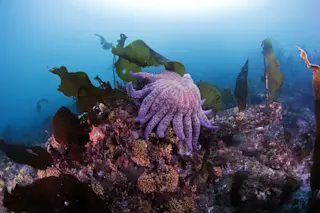A new fossil study has pinpointed the moment when whales lost their distinct legs and tail and developed flukes, sometimes called tail fins, instead:
Flukes are the two wide, flat triangular lobes on a whale's back end and are made of skin and connective tissue, with bones in the middle [National Geographic News].
Researchers say that the Georgiacetus vogtlensis, whose fossil was found in Alabama, was one of the last whales to have powerful back legs and a tail like a dog's, and that whales evolved flukes between 40 and 38 million years ago. Paleontologists already knew that
the ancestors of whales once strode on land on four legs, just as other mammals do. Over time, as they evolved to dwell in water, their front legs became flippers while they lost their back legs and hips, although modern whales all still retain traces of pelvises, and occasionally throwbacks are born ...













